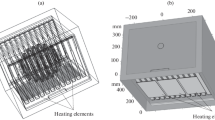Abstract—Beekeepers use electric heating of hives to overcome the difficult wintering period of bees, which is observed in late winter and early spring. The data previously given by researchers on modeling such a state of bees are not related to changes in the geometric location of aggregation of bees and changes in feed stocks in the hive. In order to properly configure the electric heater control system, the basic physical processes in the bee hive members were simulated with Comsol software. The simulation was carried out for honey stocks that were reduced by two-thirds from the initial ones and the aggregation of bees was moved from the center of the hive to the upper parts of it. Analysis of the results showed that the winter aggregation of bees at the end of the passive period requires additional ventilation of the inner space of the hive and waterlogging of the cluster can occur. The total heat capacity of honey decreased, which led to increased, but permissible temperature fluctuations within the aggregation of bees. The average temperature of the honey at the end of winter became higher, which was a positive effect, since bees could more easily take feed stocks. During this period, a redistribution of the supplied power should be carried out in partitioned heaters, thus reducing the amount of heat generated by the outermost thermal elements.






Similar content being viewed by others
REFERENCES
E. E. Southwick and J. N. Mugaas, Comp. Biochem. Physiol. A: Physiol. 40, 935 (1971).
C. D. Owens, The Thermology of Wintering Honey Bee Colonies (USDA, Agricultural Research Service, Tech. Bull. no. 1429, 1971).
A. I. Kas’yanov, Pchelovodstvo, No. 2, 16 (2003).
A. D. Trifonov, Pchelovodstvo, No. 11, 21 (1990).
A. F. Pybochkin and I. S. Zakhaprov, Computer Systems in Apiculture (Kursk. Gos. Tech. Univ., Kursk, 2004) [in Russian].
D. W. Severson and E. H. Erickson, Jr., Apidologie 21, 135 (1990).
S. V. Oskin and D. A. Ovsyannikov, Biophysics (Moscow) 65 (5), 836 (2020).
S. V. Oskin and D. A. Ovsyannikov, Biophysics (Moscow) 65 (2), 331 (2020).
E. E. Southwick, Comp. Biochem. Physiol. Part A: Physiol. 75, 641 (1983).
W. G. Meikle and N. Holst, Apidologie 46 (1), 10 (2015).
T. I. Szabo, Am. Bee J. 129, 554 (1990).
E. K. Eskov and V. A. Toboev, Zool. Zh. 90 (3), 335 (2011).
E. K. Eskov and V. A. Toboev, Biophysics (Moscow) 54 (1), 85 (2009).
V. A. Toboev and M. S. Tolstov, Nauka Obraz. 3, 116 (2014).
S. V. Oskin and D. A. Ovsyannikov, Biophysics (Moscow) 64 (1), 129 (2019).
Author information
Authors and Affiliations
Corresponding author
Ethics declarations
The authors declare that there is no conflicts of interest. This paper does not contain a description of studies using humans and animals as objects.
Additional information
Translated by E. Puchkov
Rights and permissions
About this article
Cite this article
Oskin, S.V., Ovsyannikov, D.A. & Shishigin, I.N. Modeling Beehive Microclimate at the End of Wintering. BIOPHYSICS 67, 85–91 (2022). https://doi.org/10.1134/S0006350922010122
Received:
Revised:
Accepted:
Published:
Issue Date:
DOI: https://doi.org/10.1134/S0006350922010122




